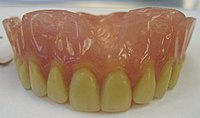
Photo from wikipedia
The purpose of this work was to demonstrate the technical feasibility for the fabrication of microgrooves or micropits on dental implants or dental implant abutment surfaces using a novel fabrication… Click to show full abstract
The purpose of this work was to demonstrate the technical feasibility for the fabrication of microgrooves or micropits on dental implants or dental implant abutment surfaces using a novel fabrication method derived from common UV-lithographic microfabrication. Instead of using a flat and rigid chromium/glass mask to structure a photoresist layer on a small cylindrical part, a flexible chromium-coated polymer mask was introduced into the lithographic setup. Through an elastic deformation of the polymer mask, it was possible to achieve lateral resolutions as small as 1.5 μm on small cylinders and to structure conical parts. By subsequent controlled under-etching of the structured photoresist layer, microgrooves of different cross-sectional geometries can be generated and applied to the implant or implant abutment surface. Such structures can be used for contact guidance of human gingival fibroblasts or endothelia cells to enhance the wound healing process and the overall soft-tissue integration.
Journal Title: Journal of Micromechanics and Microengineering
Year Published: 2020
Link to full text (if available)
Share on Social Media: Sign Up to like & get
recommendations!